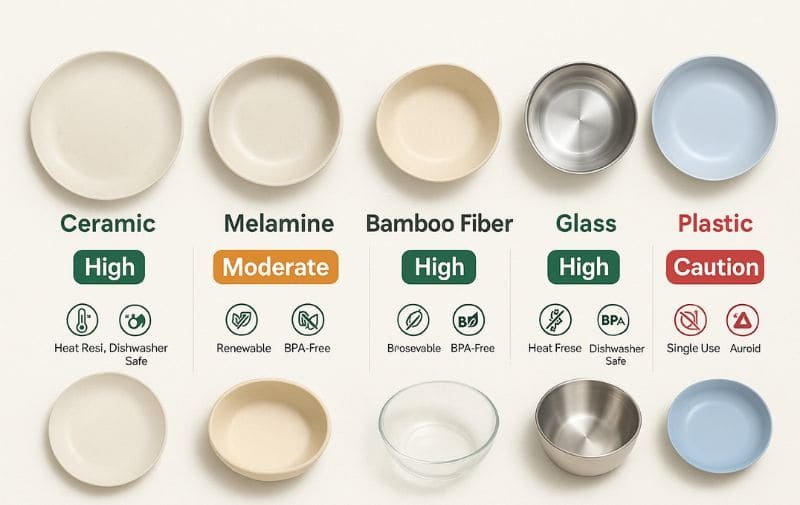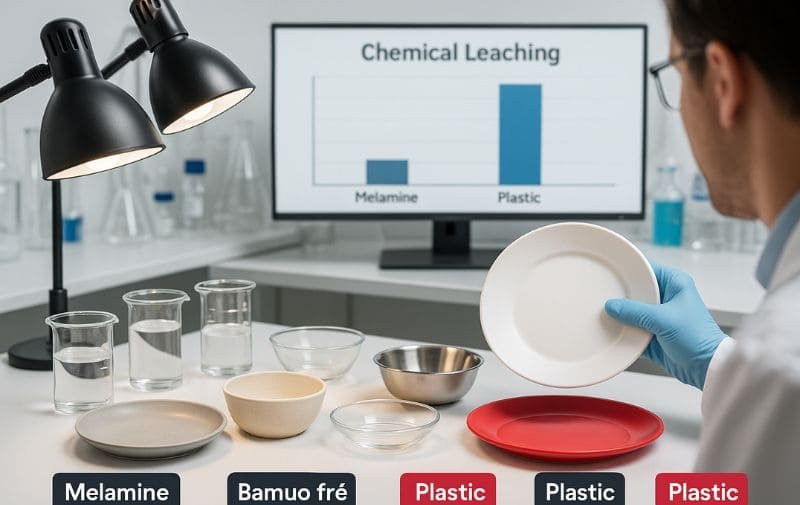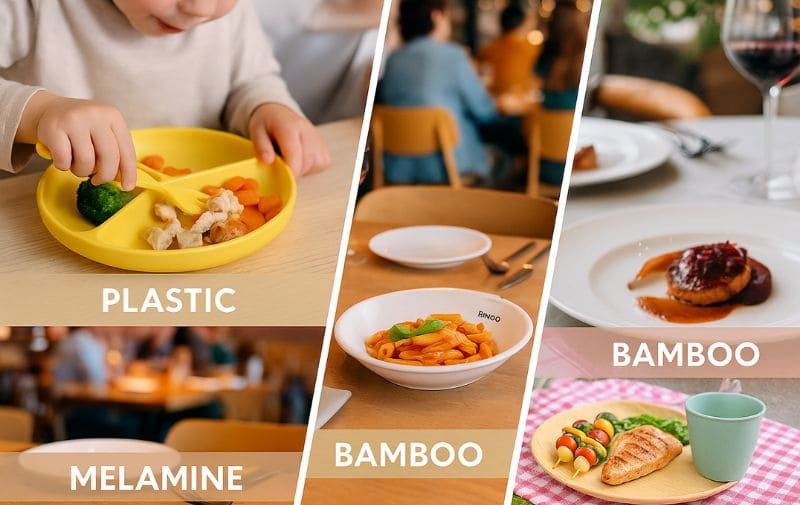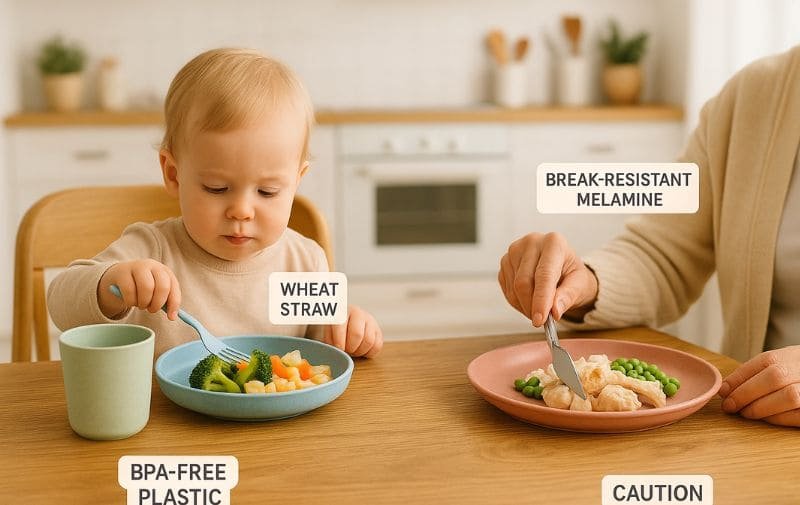You’re standing in a store, holding two different plates, and a wave of uncertainty hits you. One is ceramic, one is melamine. You’ve heard vague warnings about lead in glazes and BPA in plastics. How do you know which one is genuinely safe for your family?
Glass is often considered the safest dinnerware material as it is non-porous and inert, meaning it won’t leach chemicals into food. However, the “safest” choice truly depends on balancing four key factors: chemical safety, physical safety (breakage), microbial safety, and how you plan to use it.
The search for “non-toxic dinnerware” can feel like a minefield. As someone who helps brands navigate safety testing and material selection, I can tell you the right answer isn’t a single material. The question itself is flawed. To choose wisely, you need to stop asking “what is the safest material?” and start asking, “what is the safest material for my specific needs?”
Last Updated:Aug 16th. 2025 | Estimated Reading Time: 10 Minutes

The Flaw in the Question: Deconstructing the Four Pillars of “Safety”
Most articles will give you a simple list of materials, but this misses the point. In the dinnerware industry, we evaluate safety across four distinct dimensions. A material that excels in one area might be a poor choice in another.
True dinnerware safety is a balance of four pillars: chemical (leaching), physical (breakage), microbiological (cleanliness), and use-case (microwave/dishwasher). No single material is the best in all four categories; the safest choice is a trade-off.
Understanding this framework is the key to making a confident decision. Once you see the full picture, you can prioritize what matters most to you, whether you’re a parent with young children or a restaurateur concerned with durability.
The Four Pillars of Dinnerware Safety
| Pillar of Safety | Key Question | Primary Concerns | Materials That Excel |
|---|---|---|---|
| 1. Chemical Safety | Does it leach harmful substances into my food? | Lead, Cadmium, BPA, Melamine Monomer, Formaldehyde | Glass, High-Quality Porcelain, Certified A5 Melamine |
| 2. Physical Safety | Can it break into dangerous pieces and cause injury? | Sharp shards, shattering, chipping | High-Quality A5 Melamine, Wheat Straw Composites |
| 3. Microbiological Safety | Does it resist bacteria and can it be properly sanitized? | Porosity, scratches, glaze cracks (“crazing”) | Glass, High-Quality Porcelain, A5 Melamine |
| 4. Use-Case Safety | Is it safe for its intended purpose (e.g., microwave)? | Overheating, material degradation, chemical leaching | Glass, Porcelain, Stoneware |
The “safest” material is the one that best manages the risks most relevant to your environment.
Is It Chemically Safe? A Matter of Quality, Not Just Material
This is the concern that brings most people here: the fear of invisible toxins. The most common culprits are lead and cadmium in ceramic glazes, and BPA or melamine monomer in plastics.
Any dinnerware material can be chemically unsafe if it’s manufactured poorly. The key to safety isn’t the material’s name, but the quality of its production and whether it has passed rigorous third-party safety testing.
You cannot assume a plate is safe just because it’s “ceramic.” Here’s what you need to know.
Glass: The King of Chemical Inertness
Glass is made from natural materials like sand, soda ash, and limestone. It is non-porous and chemically inert, meaning it won’t react with food or leach any substances.
- Top Choice: Brands like Corelle, which use a unique tempered glass called Vitrelle, are exceptionally safe from a leaching perspective.
- Risk Factor: Virtually none, unless it’s painted with decorative, low-quality paints on the food-contact surface.
Ceramic, Porcelain & Stoneware: The Glaze is Key
The core ceramic material is safe. The risk comes from the glaze—the glassy coating that makes it waterproof and smooth—or from decorations applied over the glaze.
- The Danger: Low-quality or improperly fired glazes, especially in bright reds, oranges, and yellows, can contain lead and cadmium. These heavy metals can leach into acidic foods (like tomato sauce or coffee).
- How to Be Safe:
- Buy from Reputable Brands: Established manufacturers in the US and EU adhere to strict safety standards (like the FDA’s).
- Look for “Lead-Free” Labels: This is a good starting point.
- Check for Prop 65 Warnings: If you’re in California, this label warns of the presence of chemicals known to cause harm.
- Avoid Vintage & Artisanal Pieces (for eating): Use that antique plate from a flea market for decoration only, not for your dinner.
High-Quality Melamine (A5): The Science of Safety
The concern with melamine is the potential for melamine and formaldehyde monomers to migrate into food. However, this is a matter of quality and proper use.
- The Science: For certified, 100% A5 food-grade melamine, the molecular bonds are extremely stable. When used under normal, non-microwaved conditions (below 120°C / 248°F), the amount of migration is thousands of times below the strict Tolerable Daily Intake (TDI) levels set by global authorities like the FDA and the European Food Safety Authority (EFSA).
- The Danger: The risk comes from cheap, non-certified melamine (often made from A1 or A3 grade urea-formaldehyde resin) which is not designed for food contact and can be unstable. Always buy from a source that provides safety test reports.

Is It Physically Safe? The Danger of Shattering
This is the safety factor that is almost completely ignored in consumer blogs, yet it’s a leading cause of injuries in both homes and commercial kitchens.
Ceramic and glass dinnerware pose a significant physical safety risk because they shatter upon impact, creating razor-sharp shards. In environments with children, elderly individuals, or high-traffic commercial use, break-resistant materials like melamine are profoundly safer.
Think about the last time you saw a plate break. It doesn’t just crack; it explodes. Those small, sharp fragments can cause serious cuts and are difficult to clean up completely.
- The Hazard: When a ceramic, porcelain, or glass plate is dropped, it can shatter into dozens of razor-sharp shards. In a home with children, in a busy restaurant, on a patio, or in a school, this presents a significant and immediate physical danger.
- The Safer Alternative: This is where high-quality A5 melamine is the undisputed champion of safety. It is shatter-resistant. If it fails under extreme force, it may crack or break into a few large, dull-edged pieces. It does not explode into dangerous slivers.
Pro Tip: For any environment involving children, the elderly, outdoor dining, or high-traffic commercial use (restaurants, schools, hospitals), the physical safety advantage of melamine often outweighs all other considerations.
Is It Microbiologically Safe? The Threat in Pores and Scratches
A safe plate must be a clean plate. Microbiological safety refers to a material’s ability to be cleaned and sanitized effectively, without harboring bacteria.
A non-porous surface is essential for microbiological safety. Glass, high-quality porcelain, and A5 melamine all have hard, non-porous surfaces that are easy to clean and resist bacteria growth, making them excellent choices.
Pores and deep scratches are a safe haven for bacteria, where they can multiply even after the plate has been washed.
| Material | Microbiological Safety Rating | Why? |
|---|---|---|
| Glass / Vitrelle | Excellent | Completely non-porous and highly scratch-resistant. Easy to sanitize. |
| High-Quality Porcelain | Excellent | Has a hard, non-porous, vitrified glaze. Highly resistant to bacteria. |
| A5 Melamine | Excellent | Features a hard, non-porous, glazed surface that is very easy to clean and sanitize. |
| Stoneware / Earthenware | Good to Fair | Less dense than porcelain. If the glaze gets chipped or develops fine cracks (“crazing”), the porous ceramic underneath can harbor bacteria. |
| Wood / Bamboo | Fair to Poor | Naturally porous. Knife scratches and fork marks can create deep grooves where bacteria can thrive, making them difficult to sanitize fully. |
Is It Safe For Your Use-Case? The Right Material for the Right Job
The final pillar of safety relates to how you actually use your dinnerware day-to-day. The biggest dividing line here is the microwave.
Melamine dinnerware is not microwave-safe. The material can absorb microwave energy, causing it to overheat and potentially degrade. For those who frequently reheat food on their plates, glass or ceramic are the only safe options.
This is the primary limitation of melamine, but it’s important to frame it correctly. It’s a rule of use, not an inherent chemical danger when used as intended for serving. You don’t put metal in the microwave; you don’t put melamine in the microwave.
- Microwave Winners: Glass and most Ceramic/Porcelain dinnerware are microwave-safe (as long as they don’t have a metallic rim or decoration). This gives them a clear advantage in convenience for reheating.
- The Dishwasher: Nearly all modern dinnerware—including glass, ceramic, and high-quality A5 melamine—is dishwasher-safe. High heat and strong detergents in a dishwasher are perfectly fine for these durable materials.

The Buyer’s Shield: What Safety Certifications Actually Matter?
Labels can be confusing. As a buyer—whether for your home or your business—you need to know which certifications carry real weight.
For dinnerware, the most important safety standards are the FDA regulations in the US, the LFGB standard in Europe, and California’s Proposition 65. Reputable manufacturers will test their products to these standards and provide reports as proof.
Demanding to see these test reports is a non-negotiable step for any B2B buyer and a sign of a trustworthy brand for consumers.
Key Global Dinnerware Safety Standards
| Standard | Region | What It Regulates | Why It Matters |
|---|---|---|---|
| FDA CFR 21 | USA | Regulates materials that come into contact with food. Sets specific limits for leachable lead and cadmium in ceramics [3]. | This is the baseline safety requirement for any dinnerware sold legally in the United States. |
| LFGB | Germany / EU | Considered one of the strictest food safety standards in the world. Tests for a wider range of chemicals and includes a sensory test (no transfer of taste or smell). | LFGB compliance is a strong indicator of a very high-quality, safe product that has undergone rigorous testing. |
| California Prop 65 | California, USA | Requires businesses to provide warnings about significant exposures to chemicals that cause cancer, birth defects, or other reproductive harm [6]. | A Prop 65 warning doesn’t mean a product is unsafe, but that it contains one of 900+ chemicals above a certain threshold. Many ceramic products carry this warning for lead as a precaution [6]. |
The Final Verdict: What Is the Safest Dinnerware Material for YOU?
There is no single “safest” material. The safest choice is a conscious decision based on your priorities.
The Safest Choice is… A5 MELAMINE
…if your primary concern is physical safety and durability.
- Perfect for: Families with young children, outdoor/patio dining, pools, boats, RVs, schools, hospitals, and busy restaurants.
- Why: Its shatter-proof nature prevents dangerous injuries, which is a daily, real-world risk. Its chemical safety is excellent when certified and used correctly (no microwave).
The Safest Choice is… PORCELAIN or GLASS
…if your primary concern is chemical purity and microwave use.
- Perfect for: Adult-only households, those who frequently reheat food on their plates, and anyone prioritizing tradition and versatility.
- Why: These materials are chemically inert and microwave-safe. The trade-off is the constant risk of dangerous shattering if dropped.
The Safest Choice is… Plain, Clear GLASS
…if you are a health purist who demands absolute transparency.
- Perfect for: The most health-conscious consumer who wants zero ambiguity.
- Why: It has virtually no chemical leaching risk and is non-porous. It is the purest canvas for your food, though it remains a physical breakage hazard.
Conclusion
Choosing the safest dinnerware means looking beyond simple labels and understanding the bigger picture. By evaluating materials based on chemical, physical, microbiological, and use-case safety, you can confidently select the perfect plates and bowls that truly fit your life.

Your Dinnerware Safety FAQ: Answered
1. Is vintage Corelle or Pyrex safe to eat from?
It’s complicated. While the glass itself is very safe, vintage patterns (especially pre-1980s) could contain lead in their decorative paint. For daily use, it’s safest to stick with modern, plain white Corelle. Use vintage patterned pieces for occasional serving or decoration.
2. What about bone china? Is it safe?
High-quality bone china from reputable manufacturers is very safe. It is a type of porcelain that is highly vitrified and has a durable glaze. The same rules apply as for porcelain: avoid old, chipped, or unmarked pieces for food use.
3. I see “BPA-Free” on a lot of plastic plates. Does that mean they are safe?
“BPA-Free” is important, but it’s not the whole story. Some manufacturers may replace BPA with other bisphenols (like BPS) which may have similar health concerns. For plastic dinnerware, look for types made from PP (Polypropylene, #5) and avoid those with recycling codes #3 (PVC), #6 (Polystyrene), and #7 (Other, which can include polycarbonate/BPA).
4. Are bamboo plates a safe, natural option?
Be cautious. Most “bamboo” dinnerware is not pure bamboo. It’s a composite of bamboo fiber mixed with a binder, which is often melamine resin. The safety of these products depends entirely on the quality of the resin and the manufacturing process. Look for products with food-grade safety certifications.
5. How can I test my plates for lead at home?
You can buy home lead test kits from hardware stores. These kits involve a swab that changes color in the presence of lead. While not as accurate as a lab test, they can be a good screening tool for suspicious vintage or imported ceramic ware.
6. Does the country of origin matter for dinnerware safety?
Not necessarily. What matters is the manufacturer’s commitment to quality control and adherence to international safety standards. A high-quality factory in any country can produce safe products, and a low-quality one can produce unsafe products. Your best defense is to buy from reputable brands and demand test reports.



